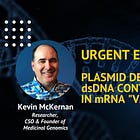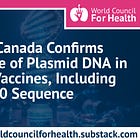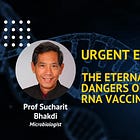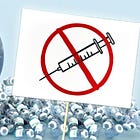Written by World Council for Health Correspondent Alice Ashwell, PhD.
Professor Alexandra Henrion-Caude, former Director of Research at the French NIH, is internationally recognised for her work on mitochondrial mRNAs. Since speaking out publicly in March 2020 against the Covid health policies, she has become one of Europe’s foremost activists for health sovereignty in academic circles. In 2023 she published the best-selling book, The Sorcerer’s Apprentices: Everything they’re not telling you about messenger RNA, which questions the ethics of the global rollout of the inadequately studied mRNA ‘vaccines’.
Her presentation was a peep into the Pandora’s box of possible triggers that may enhance integration of plasmid DNA found in the Pfizer and Moderna Covid ‘vaccines’ into the human genome.
Visit worldcouncilforhealth.org/dna to watch the full hearing and sign up for updates about #PlasmidGate as more information becomes available. We are pleased to let you know that a follow-up hearing to that historic event is taking place Monday the 27th of November 2023 addressing the legal implications of these findings.
Why Are Scientists So Concerned?
Prof Henrion-Caude started her presentation with an image illustrating the enormous complexity of the process of DNA replication within a living cell. She warned of the risk of introducing any sort of foreign genetic material, whether mRNA or plasmid DNA, into this complex system.
It is hard to believe that after two years of ‘vaccine’ rollout, the regulatory bodies in Europe (the EMA) and the United States (the CDC) were unable to prove that the injections were safe in terms of possible genotoxic or carcinogenic effects. When approached for information, the responses of both agencies were extremely disturbing and indicated a complete lack of concern regarding the possible effects of the injections.
It is the responsibility of these regulatory agencies to research potential genotoxic and carcinogenic effects of the injections, to ensure that the products are safe, and to release this information to the public. But in fact, they have done exactly the opposite, leaving it to independent researchers to demonstrate the toxicity of those shots.
Can Foreign DNA Enter the Nucleus of a Cell?
The existence of circulating cell-free DNA was first described as long ago as 1948 by Mandel. There are many sources of exposure to foreign or modified DNA sequences, including diet, degraded apoptotic cells, cancer cells, viruses, bacteria, and vaccines. Most fragments originate from the death of host cells (apoptosis). Circulating DNA fragments are able to resist serum nuclease activity and survive because they circulate as nucleoprotein complexes adsorbed to the surface of blood cells.
The possibility of foreign DNA being integrated into human cells is a big concern. Normally, DNA does not diffuse passively across cell membranes. In the case of the vaccine, however, nucleic acid is encased in lipid nanoparticles (LNPs), which enables it to enter the cytoplasm of a number of cells.
Entry into the nucleus is limited to the nuclear pore complexes, except when the nuclear envelope disassembles at the end of the prophase of mitosis. Since the mid-1990s we have known that plasmid DNA can translocate through the nuclear pores into the nuclei of non-dividing cells. The ability of the Simian Virus (SV) 40 viral genome to enter the nucleus of nondividing cells led to the discovery of DNA nuclear targeting sequences that enable this to take place. The SV40 nuclear localisation signal peptide was subsequently exploited to enhance transfection efficiency.
Once foreign DNA enters the nucleus, integration into the host’s DNA is a very rare event. Transformation frequencies differ greatly from one cell to the other. Rates vary from 0.1% to 6% in cells in vitro, but as yet we have no idea of the transformation frequency in vivo.
Foreign DNA fragments can undergo numerous modifications and rearrangements prior to integration, including being truncated, concatenated into tandem repeats, or interspersed with other DNA segments during the process of integration.
Finding DNA in the Covid ‘Vaccines’ Raises Concerns
Prof Henrion-Caude noted that having little capsules (LNPs) of foreign DNA circulating in the bloodstream may promote cancer metastasis.
She also raised concerns about factors that could enhance the integration of foreign DNA from the Covid ‘vaccines’ into the human genome, including:
A number of people who received the mRNA Covid ‘vaccines’ also received an adenoviral-based injection. This is of concern as we have known for a long time that adenoviruses may enable DNA integration. In fact, adenovirus vectors have been used in genome editing of haematopoietic stem cells (stem cells that give rise to other blood cells).
Some drugs may enhance integration; for example, bleomycin can enhance random integration of any transfected DNA into the human genome.
Radiation may enhance integration, as demonstrated in the case of proton-induced DNA damage of the human genome. This may apply to any sort of radiation that enhances DNA damage.
Genome plasticity may also enhance integration. This may apply to human brain cells, for example, which undergo numerous chromosomal conformation changes during the developmental process.
Other unknown contaminants may enhance integration. Contaminants could conceivably include CRISPR-Cas technology, which would be a serious concern.
Prof Henrion-Caude’s list of factors that may enhance the integration of contaminant DNA into the human genome is quite shocking. Did the pharmaceutical companies know what they were doing, or is this catastrophic situation due to sloppy manufacturing? We cannot tell.
What is clear, though, is that this situation clearly illustrates why novel biopharmaceutical products should NEVER be rushed to market, and NEVER be forced on the majority of the human population.
Related content on WCH Substack:
If you find value in this Substack and have the means, please consider making a contribution to support the World Council for Health. Thank you.










Share this post